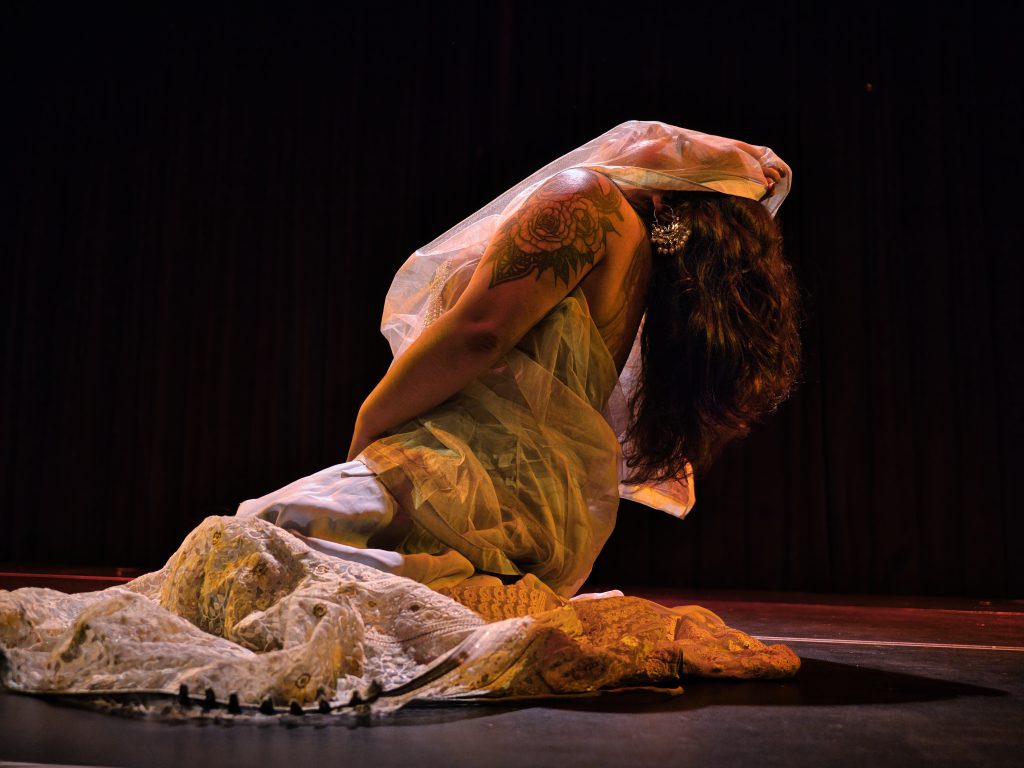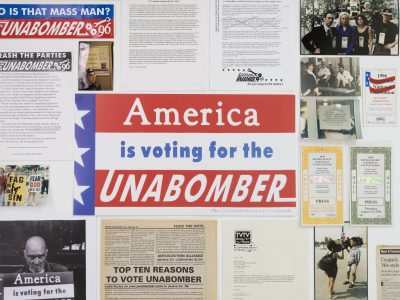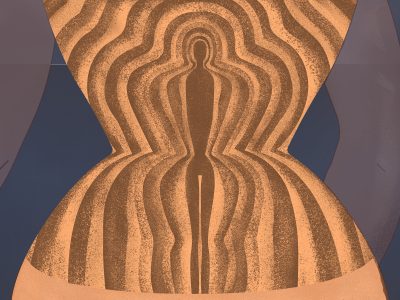WP_Post Object
(
[ID] => 9828
[post_author] => 15
[post_date] => 2025-12-12 10:00:00
[post_date_gmt] => 2025-12-12 10:00:00
[post_content] =>
An essay about fibroids, and the time I bled on the floor at work.
Several years ago, I had an operation to remove eight uterine fibroids. One was roughly the size of a grapefruit; another, an orange.
Despite the hour-long cardio kickboxing class I was then taking five times a week, I had been putting on weight—probably just muscle mass, I’d deludedly thought at the time. But my abdomen was noticeably protruding, and I had gone from having heavy periods to bleeding uncontrollably at times that were unconnected to my usual menstrual cycle. I looked and felt like I was four months pregnant, minus the motherly glow: all of the eerie, alien sensations of pregnancy with none of the compensations of a yearned-for baby. I could feel the fibroids’ taut mass when I woke up in the morning, like a brick in my belly, and I had to pee constantly—so much and so often that I was afraid to go anywhere without knowing where the nearest bathroom was. I knew, as you often do, that something was wrong.
Fibroids are uterine muscle cells that grow in a ball or clump. They can be as small as a pea, or as large as a full-term baby. They can grow inside or outside of the uterus, directly on the uterine wall, or from a “stalk” made of smooth muscle cells.
They’re also incredibly common: Many women have them, but you wouldn’t necessarily know unless you had symptoms. Black women are more likely than other women to get them, and more likely to need treatment. Larger fibroids and those that grow at the end of the vaginal tract can make penetrative sex painful—something I never experienced, though they did shrink my once prodigious libido, as neither the word “fibroids” nor the thing itself is a known aphrodisiac.
In rare cases, fibroids can resolve on their own. Mine had to be surgically removed because they were causing me to bleed as suddenly and copiously as if I’d been stabbed—including one time when I bled through a super-plus tampon onto the floor at work. A male coworker had pointed out the small puddle of blood forming beneath my desk, wondering aloud where it had come from: Was the ceiling weeping blood, like something out of a horror movie? I pretended I had cut my leg and fled to the ladies’ room, eventually returning, mortified, to mop up the blood with a Lysol wipe. My coworkers were kind enough to accept, and even pretend to believe, the bizarre claim that I had somehow injured my leg, when both were visibly bare and intact.
It wasn’t the first time my fibroids had made themselves known. Several months earlier, I’d bled through an ultra-absorbent tampon at a movie theater while watching a documentary about Ruth Bader Ginsburg. It was summer; I was wearing pale green shorts. When I stood up, rivulets of blood poured down the backs of my legs and pooled in my sneakers.
Another time, despite the presence of another super-plus tampon and a gigantic, diaper-like maxi pad, I ruined a set of white sheets on a bed in a house my parents were renting. My sister-in-law—a social worker who’s seen worse—helped me change the sheets.
Then there was the time I started bleeding heavily while waiting in line for an international flight. The floodgates opened just after an airline employee summoned me, by name, to the check-in desk, where I was asked to produce my passport for a random extra security check. As I boarded the flight, I squeezed my legs together and prayed. During takeoff, I pressed a scratchy airplane blanket into my lap like a tourniquet.
It was in a period of painful transitions that my symptoms were most acute: six failed job interviews and three funerals, two for grandparents and one for my parents’ oldest and closest friend. All the black clothes came in handy. When it got hot again, I bought a hideous, tent-like maxi dress made of thick black cotton. I hated how it looked—too funereal for summer—but loved that it was ankle-length and absorptive.
After months of heavy bleeding and diagnostic tests—CT scans and ultrasounds and endless consultations—I had a myomectomy. At some point I started looking into what causes fibroids; as with so many medical problems women suffer, the answer was a combination of, “We don’t know” and “Try losing some weight.” Being overweight or obese is a risk factor, as is consuming red meat and alcohol, especially beer. Nulliparity, or never having given birth, is another. I am neither sylphlike nor fat. My weight has fluctuated over the years, but rarely by more than 15 pounds. As far as I know, I have never been pregnant. I have often consumed red meat and alcohol, including beer, though I’ve attempted to rein in these vices as I’ve gotten older. While I don’t blame my love of beer and bacon for my fibroids, it was hard to read about the risk factors without feeling indicted—and, in my case, mulish and defiant. (“Especially beer?” I muttered to myself while researching. “Who came up with this list, my mom?”)
Thinking it might shrink my fibroids to a manageable size or keep them from growing back, and liking the idea of grandkids, my sweet-natured, supportive dad once gently floated pregnancy as a possible solution. I’ve always been ambivalent about motherhood and resent pressure and unsolicited advice of any kind. But it wasn’t a crazy suggestion. I am in a stable and happy long-term relationship with a man who is also ambivalent about parenthood, but would have done his best to knock me up if I’d asked.
Getting pregnant wouldn’t necessarily have solved the problem, either. Pregnancy, with its wild hormone fluctuations and variable uterine blood flow, can shrink fibroids, but it can also cause them to grow. Fibroids can also increase the risk of a miscarriage, premature birth, breech birth, or placental abruption, a serious condition in which the placenta separates from the inner wall of the uterus, potentially causing the person giving birth to bleed heavily and/or cutting off the baby's supply of oxygen and nutrients. In other words, an unexpected pregnancy could shrink my fibroids—or kill me and my baby. And regardless of what I want, part of being a woman is knowing that millions of people around the world would find either scenario acceptable.
After the surgery, I was out of commission for six weeks. It took me a week to have a normal bowel movement again, and more for my energy and strength to return. I was forbidden to engage in any physical activity more strenuous than walking. Just out of the operating room and still doped up, I’d slurred that I was from a family of nurses and social workers (I didn’t mention the lawyers), and that I thought that nurses were underpaid saints. The nurse on duty said, “I like you! I’m gonna put you in one of the good rooms.” It was a private room on a high floor with a stunning view of the East River. My partner folded his large frame onto a tiny couch-bed in the corner and slept there for several nights.
On the first night, two nurses helped me drag my body out of the hospital bed so I could pee. One of the incisions opened up, sending a hefty splash of pooled blood shooting out of my side. It wasn’t painful and I was too out of it to be frightened, but my partner looked like he’d seen a baby get hit by a car. The nurses muscled me back into bed. It turned out I needed a transfusion, which meant lying still for several hours while feeling the prickly, itchy, ghostly sensation of being pumped full of a stranger’s blood. When I moved the wrong way, I’d inadvertently tug on the IV catheter, sending a hot, throbbing ache skittering across the surface of the skin where they’d stuck the needle.
When I was discharged, a kind but stern nurse with a mellifluous Caribbean accent told me not to do any heavy lifting for at least three weeks. “That means no housework—no mopping or vacuuming, nothing like that,” she said. My partner and I grinned at each other. “I mean it, now!” said the nurse, misinterpreting our amusement and sending us into a fit of laughter. She seemed to think I was the kind of woman who can’t stand to keep a filthy house no matter what the doctor says, rather than the kind who lived, for years, alone and happy in a tiny, dusty, book-filled bachelor pad I almost never cleaned.
Fibroids can grow back, and mine did, necessitating another procedure just one year after the first, and another one after that. Each time, I was newly amazed by my body’s fragility and resilience: the skin, so easily pierced, slowly knitting itself back together again; the scars, so angry and ropy and red, fading to pale pink, sliver-like threads over time.
Harder to quantify was the return of my strength and confidence after years of feeling conspicuous and out of control. The fibroids heightened my anxiety—unless or until I get a hysterectomy or undergo menopause, they can always recur. Not knowing how my own body is going to behave at any given moment makes it difficult to stay sanguine. But maybe because I am close to a number of women who regard their own bodies with shame and ambivalence, I’m determined not to be ashamed of mine. I take a certain amount of perverse satisfaction in telling the story of the Time I Bled on the Floor at Work. When it happened, I was profoundly embarrassed but not ashamed, and I still find the whole episode deeply, darkly funny.
A friend once said that he hates bodies and wishes we could exist as pure spirits, free from the constant, undignified labor of keeping our corporeal forms healthy and strong. I often feel this way. At the same time, I am in awe of my body and consider its restoration a minor miracle. I may never be able to master it fully, but I’m grateful I could rebuild and transcend it.
[post_title] => Female Trouble
[post_excerpt] => An essay about fibroids, and the time I bled on the floor at work.
[post_status] => publish
[comment_status] => closed
[ping_status] => closed
[post_password] =>
[post_name] => uterine-fibroids-myomectomy-personal-essay-womens-health-bodies
[to_ping] =>
[pinged] =>
[post_modified] => 2025-12-14 00:58:10
[post_modified_gmt] => 2025-12-14 00:58:10
[post_content_filtered] =>
[post_parent] => 0
[guid] => https://conversationalist.org/?p=9828
[menu_order] => 0
[post_type] => post
[post_mime_type] =>
[comment_count] => 0
[filter] => raw
)
















